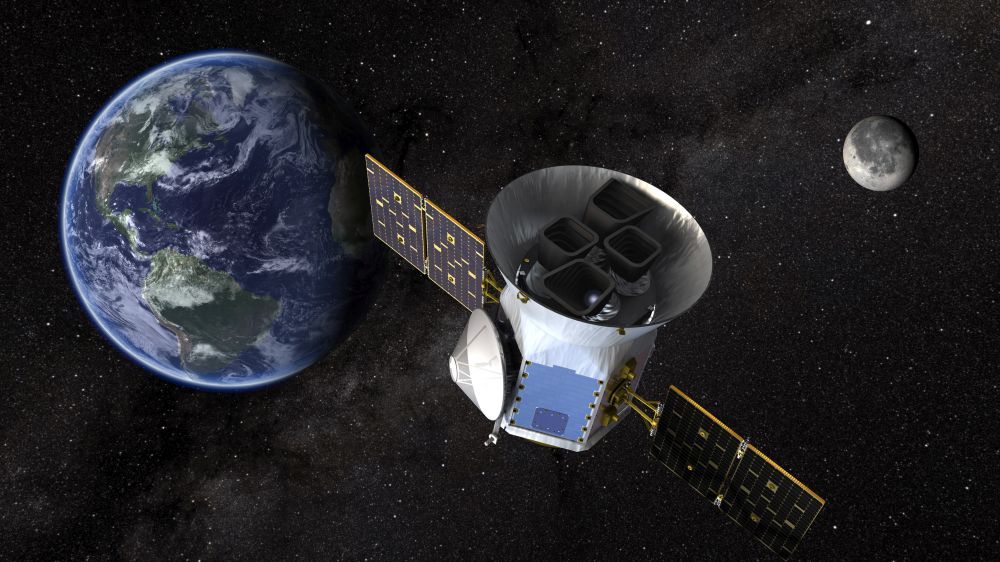Astronomers working with TESS (Transiting Exoplanet Survey Satellite) data have found a planet where it shouldn’t be: in the space recently filled by its host star when it was a red giant.
Continue reading “It Seems Impossible, But Somehow This Planet Survived its Star’s Red Giant Phase”The Planet-Hunting TESS Discovers Its Smallest Exoplanet to Date
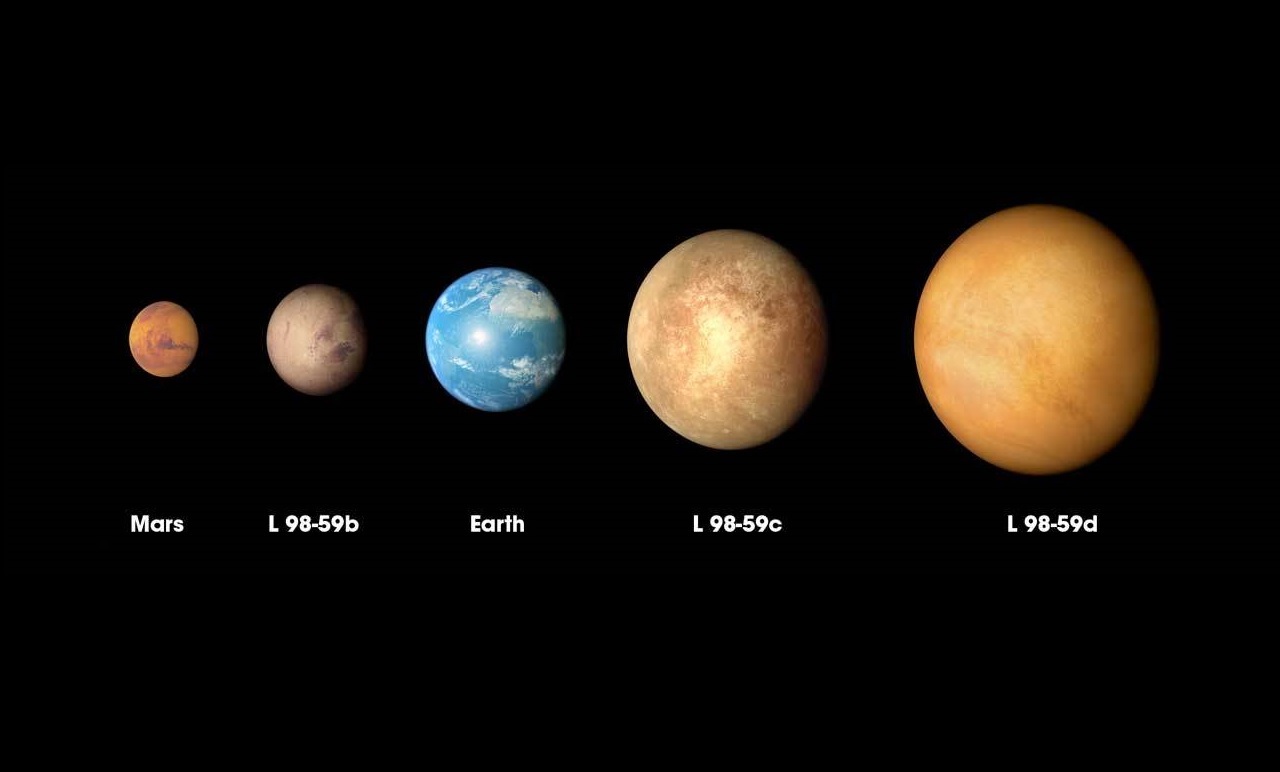
Thanks in large part to the Kepler Space Telescope, the number of confirmed extrasolar planets has grown exponentially in the last decade. And with next-generation missions like the Transiting Exoplanet Survey Satellite (TESS) already in orbit, more candidates and confirmed planets are being discovered all the time – many of them new and exciting ones too!
In fact, one of TESS’ most recent discoveries includes a three-planet system that orbits a star (L 98-59) located roughly 35 light-years from Earth. One of the planets, known as L 98-59b, is between the sizes of Earth and Mars – effectively making it the smallest exoplanet discovered by TESS to date. The discovery also highlights the sophistication of TESS and doubles the number of small exoplanets that are considered worthy of follow-up studies.
Continue reading “The Planet-Hunting TESS Discovers Its Smallest Exoplanet to Date”What is the Direct Imaging Method?

Welcome back to the latest installment in our series on Exoplanet-hunting methods. Today we begin with the very difficult, but very promising method known as Direct Imaging.
In the past few decades, the number of planets discovered beyond our Solar System has grown by leaps and bounds. As of October 4th, 2018, a total of 3,869 exoplanets have been confirmed in 2,887 planetary systems, with 638 systems hosting multiple planets. Unfortunately, due to the limitations astronomers have been forced to contend with, the vast majority of these have been detected using indirect methods.
So far, only a handful of planets have been discovered by being imaged as they orbited their stars (aka. Direct Imaging). While challenging compared to indirect methods, this method is the most promising when it comes to characterizing the atmospheres of exoplanets. So far, 100 planets have been confirmed in 82 planetary systems using this method, and many more are expected to be found in the near future.
Continue reading “What is the Direct Imaging Method?”TESS Practices on a Comet Before Starting on its Science Operations

On April 18th, 2018, NASA deployed the Transiting Exoplanet Survey Satellite (TESS), a next-generation exoplanet hunting telescope that is expected to find thousands of planets in the coming years. Alongside other next-generation telescopes like the James Webb Space Telescope (JWST), TESS will effectively pick up where space telescopes like Hubble and Kepler left off.
The mission recently started science operations (on July 25th, 2018) and is expected to transmit its first collection of data back to Earth this month. But before that, the planet-hunting telescope took a series of images that featured a recently-discovered comet known as C/2018 N1. These images helped demonstrate the satellite’s ability to collect images over a broad region of the sky – which will be critical when it comes to finding exoplanets.
As the name would suggest, the TESS mission is designed to search for planets around distant stars using the Transit Method (aka. Transit Photometry). For this method, distant stars are monitored for periodic dips in brightness, which are indications that a planet is passing in front of the star (aka. transiting) relative to the observer. From these dips, astronomers are able to estimate a planet’s size and orbital period.
This method remains the most effective and popular means for finding exoplanets, accounting for 2,951 of the 3,774 confirmed discoveries made to date. To test its instruments before it began science operations, TESS took images of C/2018 N1 over a short period near the end of the mission’s commissioning phase – which occurred over the course of 17 hours on July 25th.
The comet that it managed to capture, C/2018 N1, was discovered by NASA’s Near-Earth Object Wide-field Infrared Survey Explorer (NEOWISE) satellite on June 29th. This comet is located about 48 million km (29 million mi) from Earth in the southern constellation Piscis Austrinus. In these pictures, which were compiled into a video (shown below), the comet is seen as a bright dot against a background of stars and other objects.
As it moves across the frame (from right to left), the comet’s tail can be seen extending to the top of the frame, and gradually changes direction as the comet glides across the field of view. The images also reveal a considerable amount of astronomical activity in the background. For instance, image processing causes the stars to shift between white and black, which highlights some variable stars visible in the images.
These are stars that change brightness as a result of pulsation, rapid rotation, or being eclipsed by a binary neighbor. A number of Solar System asteroids are also visible as small white dots moving across the field of view. Last, but not least, some stray light that was reflected from Mars is also visible near the end of the video. This light appears as a faint broad arc that moves across the middle section of the frame, from left to right.
This effect was due to the fact that Mars was at its brightest at the time since it was near opposition (i.e. at the closest point in its orbit to Earth). These images showcase the capabilities of the TESS mission, even though they only show a fraction of the instrument’s active field of view.
In the coming weeks and months, TESS science team will continue to fine-tune the spacecraft’s performance as it searches for extra-solar planets. As noted, it is expected that TESS will find thousands of planets in our galaxy, vastly increasing our knowledge of exoplanets and the kinds of worlds that exist beyond our Solar System!
And be sure to check out the video of the images TESS captured, courtesy of NASA’s Goddard Space Flight Center:
Further Reading: NASA
NASA’s James Webb Space Telescope will Inspect the Atmospheres of Distant Gas Giants
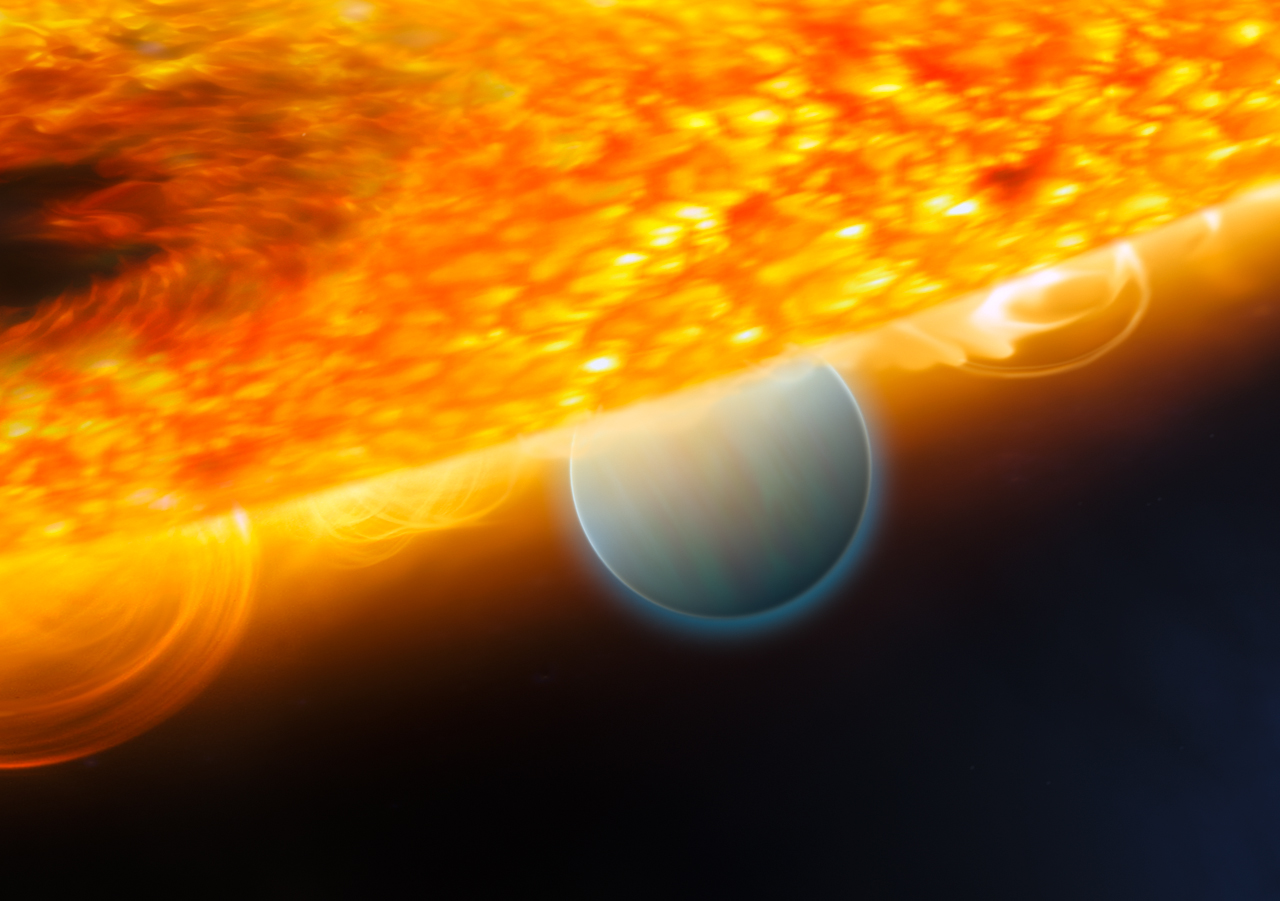
The James Webb Space Telescope is like the party of the century that keeps getting postponed. Due to its sheer complexity and some anomalous readings that were detected during vibration testing, the launch date of this telescope has been pushed back many times – it is currently expected to launch sometime in 2021. But for obvious reasons, NASA remains committed to seeing this mission through.
Once deployed, the JWST will be the most powerful space telescope in operation, and its advanced suite of instruments will reveal things about the Universe that have never before been seen. Among these are the atmospheres of extra-solar planets, which will initially consist of gas giants. In so doing, the JWST will refine the search for habitable planets, and eventually begin examining some potential candidates.
The JWST will be doing this in conjunction with the Transiting Exoplanet Survey Satellite (TESS), which deployed to space back in April of 2018. As the name suggests, TESS will be searching for planets using the Transit Method (aka. Transit Photometry), where stars are monitored for periodic dips in brightness – which are caused by a planet passing in front of them relative to the observer.

Some of Webb’s first observations will be conducted through the Director’s Discretionary Early Release Science program – a transiting exoplanet planet team at Webb’s science operation center. This team is planning on conducting three different types of observations that will provide new scientific knowledge and a better understanding of Webb’s science instruments.
As Jacob Bean of the University of Chicago, a co-principal investigator on the transiting exoplanet project, explained in a NASA press release:
“We have two main goals. The first is to get transiting exoplanet datasets from Webb to the astronomical community as soon as possible. The second is to do some great science so that astronomers and the public can see how powerful this observatory is.”
As Natalie Batalha of NASA Ames Research Center, the project’s principal investigator, added:
“Our team’s goal is to provide critical knowledge and insights to the astronomical community that will help to catalyze exoplanet research and make the best use of Webb in the limited time we have available.”
For their first observation, the JWST will be responsible for characterizing a planet’s atmosphere by examining the light that passes through it. This happens whenever a planet transits in front of a star, and the way light is absorbed at different wavelengths provides clues as to the atmosphere’s chemical composition. Unfortunately, existing space telescopes have not had the necessary resolution to scan anything smaller than a gas giant.
The JWST, with its advanced infrared instruments, will examine the light passing through exoplanet atmospheres, split it into a rainbow spectrum, and then infer the atmospheres’ composition based on which sections of light are missing. For these observations, the project team selected WASP-79b, a Jupiter-sized exoplanet that orbits a star in the Eridanus constellation, roughly 780 light-years from Earth.
The team expects to detect and measure the abundances of water, carbon monoxide, and carbon dioxide in WASP-79b, but is also hoping to find molecules that have not yet been detected in exoplanet atmospheres. For their second observation, the team will be monitoring a “hot Jupiter” known as WASP-43b, a planet which orbits its star with a period of less than 20 hours.
Like all exoplanets that orbit closely to their stars, this gas giant is tidally-locked – where one side is always facing the star. When the planet is in front of the star, astronomers are only able to see its cooler backside; but as it orbits, the hot day-side slowly comes into view. By observing this planet for the entirety of its orbit, astronomers will be able to observe those variations (known as a phase curve) and use the data to map the planet’s temperature, clouds, and atmospheric chemistry.
This data will allow them to sample the atmosphere to different depths and obtain a more complete picture of the planet’s internal structure. As Bean indicated:
“We have already seen dramatic and unexpected variations for this planet with Hubble and Spitzer. With Webb we will reveal these variations in significantly greater detail to understand the physical processes that are responsible.”

For their third observation, the team will be attempting to observe a transiting planet directly. This is very challenging, seeing as how the star’s light is much brighter and therefore obscures the faint light being reflected off the planet’s atmosphere. One method for addressing this is to measure the light coming from a star when the planet is visible, and again when it disappears behind the star.
By comparing the two measurements, astronomers can calculate how much light is coming from the planet alone. This technique works best for very hot planets that glow brightly in infrared light, which is why they selected WASP-18b for this observation – a hot Jupiter that reaches temperatures of around 2,900 K (2627 °C; 4,800 °F). In the process, they hope to determine the composition of the planet’s smothering stratosphere.
In the end, these observations will help test the abilities of the JWST and calibrate its instruments. The ultimate goal will be to examine the atmospheres of potentially-habitable exoplanets, which in this case will include rocky (aka. “Earth-like”) planets that orbit low mass, dimmer red dwarf stars. In addition to being the most common star in our galaxy, red dwarfs are also believed to be the most likely place to find Earth-like planets.

As Kevin Stevenson, a researcher with the Space Telescope Science Institute and a co-principal investigator on the project, explained:
“TESS should locate more than a dozen planets orbiting in the habitable zones of red dwarfs, a few of which might actually be habitable. We want to learn whether those planets have atmospheres and Webb will be the one to tell us. The results will go a long way towards answering the question of whether conditions favorable to life are common in our galaxy.”
The James Webb Space Telescope will be the world’s premier space science observatory once deployed, and will help astronomers to solve mysteries in our Solar System, study exoplanets, and observe the very earliest periods of the Universe to determine how its large-scale structure evolved over time. For this reason, its understandable why NASA is asking that the astronomical community be patient until they are sure it will deploy successfully.
When the payoff is nothing short of ground-breaking discoveries, it’s only fair that we be willing to wait. In the meantime, be sure to check out this video about how scientists study exoplanet atmospheres, courtesy of the Space Telescope Science Institute:
Further Reading: NASA
Kepler’s Almost Out of Fuel. It’ll Make its Last Observation in a Few Months
Since its deployment in March of 2009, the Kepler space telescope has been a boon for exoplanet-hunters. As of March 8th, 2018, a total of 3,743 exoplanets have been confirmed, 2,649 of which were discovered by Kepler alone. At the same time, the telescope has suffered its share of technical challenges. These include the failure of two reaction wheels, which severely hampered the telescope’s ability to conduct its original mission.
Nevertheless, the Kepler team was able to return the telescope to a stable configuration by using small amounts of thruster fuel to compensate for the failed reaction wheels. Unfortunately, after almost four years conducting its K2 observation campaign, the Kepler telescope is now running out fuel. Based on its remaining fuel and rate of consumption, NASA estimates that the telescope’s mission will end in a few months.
For years, the Kepler space telescope has been locating planets around distant stars using the Transit Method (aka. Transit Photometry). This consists of monitors stars for periodic dips in brightness, which are caused by a planet passing in front of the star (i.e. transiting). Of all the methods used to hunt for exoplanets, the Transit Method is considered the most reliable, accounting for a total of 2900 discoveries.
Naturally, this news comes as a disappointment to astronomers and exoplanet enthusiasts. But before anyone starts lamenting the situation, they should keep some things in mind. For one, the Kepler mission has managed to last longer than anyone expected. Ever since the K2 campaign began, the telescope has been required to shift its field of view about every three months to conduct a new observation campaign.
Based on their original estimates, the Kepler team believed they had enough fuel to conduct 10 more campaigns. However, the mission has already completed 16 campaigns and the team just began their 17th. As Charlie Sobeck, a system engineer for the Kepler space telescope mission, explained in a recent NASA press statement:
“Our current estimates are that Kepler’s tank will run dry within several months – but we’ve been surprised by its performance before! So, while we anticipate flight operations ending soon, we are prepared to continue as long as the fuel allows. The Kepler team is planning to collect as much science data as possible in its remaining time and beam it back to Earth before the loss of the fuel-powered thrusters means that we can’t aim the spacecraft for data transfer. We even have plans to take some final calibration data with the last bit of fuel, if the opportunity presents itself.”
So while the mission is due to end soon, the science team hopes to gather as much scientific data as possible and beam it back to Earth before then. They also hope to gather some final calibration data using the telescope’s last bit of fuel, should the opportunity present itself. And since they cannot refuel the spacecraft, they hope to stop collecting data so they can use their last bit of fuel to point the spacecraft back towards Earth and bring it home.
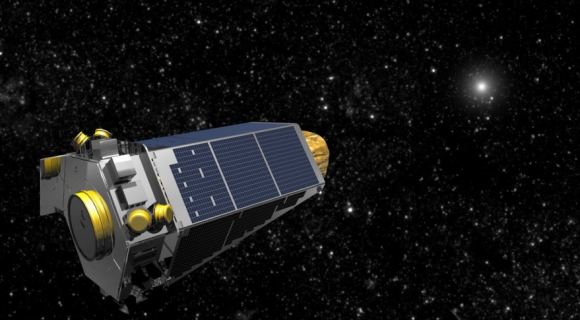
“Without a gas gauge, we have been monitoring the spacecraft for warning signs of low fuel— such as a drop in the fuel tank’s pressure and changes in the performance of the thrusters,” said Sobeck. “But in the end, we only have an estimate – not precise knowledge. Taking these measurements helps us decide how long we can comfortably keep collecting scientific data.”
This has been standard practice for many NASA missions, where enough fuel has been reserved to conduct one last maneuver. For example, the Cassini mission had to reserve fuel in order to descend into Saturn’s atmosphere so it would avoid colliding with one of its moons and contaminating a potentially life-bearing environment. Satellites also regularly conduct final maneuvers to ensure they don’t crash into other satellites or fall to Earth.
While deep-space missions like Kepler are in no danger of crashing to Earth or contaminating a sensitive environment, this final maneuver is designed to ensure that the science team can squeeze every last drop of data from the spacecraft. So before the mission wraps up, we can expect that this venerated planet-hunter will have some final surprises for us!
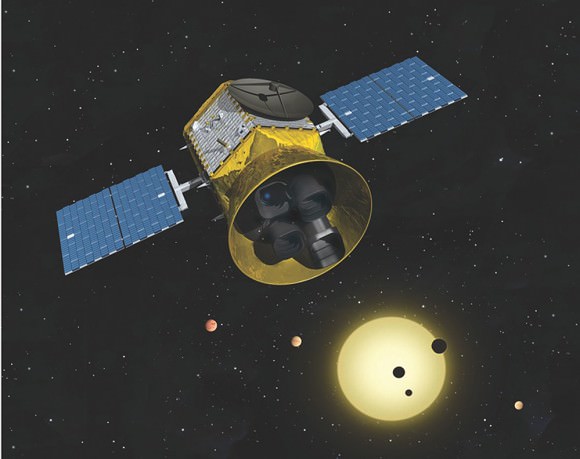
In the coming years, next-generation telescopes will be taking to space to pick up where Kepler and other space telescopes left off. These include the Transiting Exoplanet Survey Satellite (TESS), which will be conducting Transit surveys shortly after it launches in April of 2018. By 2019, the James Webb Space Telescope (JWST) will also take to space and use its powerful infrared instruments to aid in the hunt for exoplanets.
So while we will soon be saying goodbye to the Kepler mission, its legacy will live on. In truth, the days of exoplanet discovery are just getting started!
Stay tuned for updates from the Kepler and K2 Science Center.
Further Reading: NASA
For the First Time, Planets Have Been Discovered in ANOTHER Galaxy!
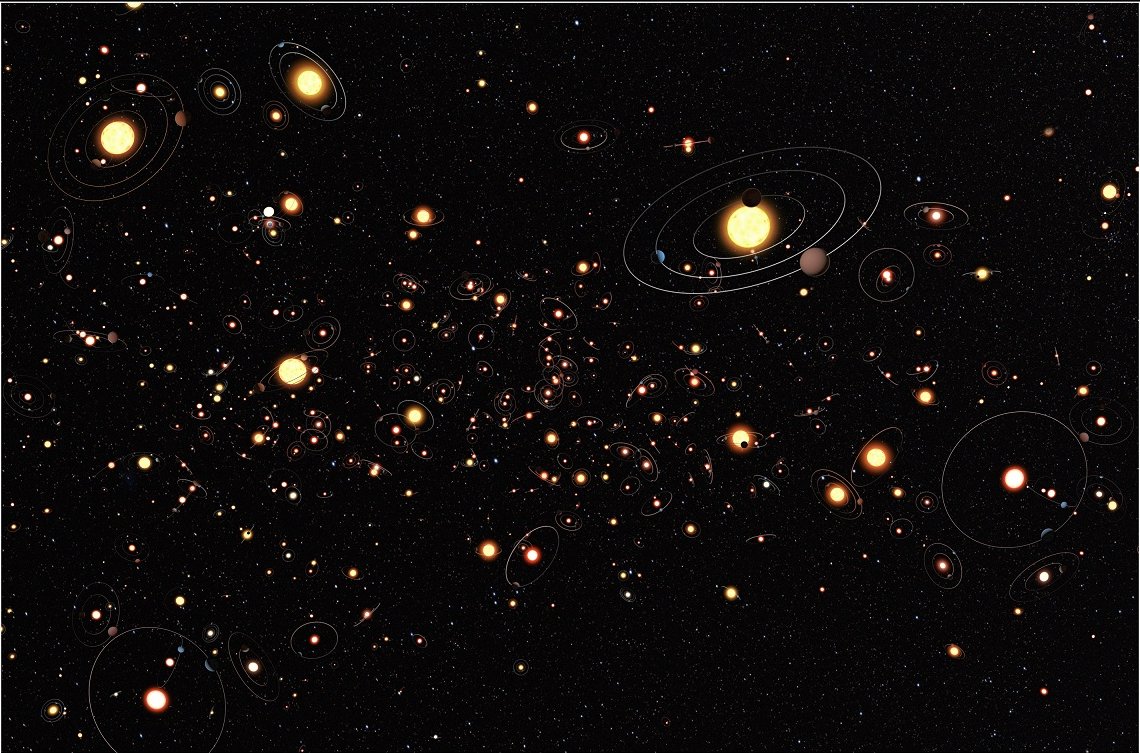
The first confirmed discovery of a planet beyond our Solar System (aka. an Extrasolar Planet) was a groundbreaking event. And while the initial discoveries were made using only ground-based observatories, and were therefore few and far between, the study of exoplanets has grown considerably with the deployment of space-based telescopes like the Kepler space telescope.
As of February 1st, 2018, 3,728 planets have been confirmed in 2,794 systems, with 622 systems having more than one planet. But now, thanks to a new study by a team of astrophysicists from the University of Oklahoma, the first planets beyond our galaxy have been discovered! Using a technique predicting by Einstein’s Theory of General Relativity, this team found evidence of planets in a galaxy roughly 3.8 billion light years away.
The study which details their discovery, titled “Probing Planets in Extragalactic Galaxies Using Quasar Microlensing“, recently appeared in The Astrophysical Journal Letters. The study was conducted by Xinyu Dai and Eduardo Guerras, a postdoctoral researcher and professor from the Homer L. Dodge Department of Physics and Astronomy at the University of Oklahoma, respectively.
For the sake of their study, the pair used the Gravitational Microlensing technique, which relies on the gravitational force of distant objects to bend and focus light coming from a star. As a planet passes in front of the star relative to the observer (i.e. makes a transit), the light dips measurably, which can then be used to determine the presence of a planet.
In this respect, Gravitational Microlensing is a scaled-down version of Gravitational Lensing, where an intervening object (like a galaxy cluster) is used to focus light coming from a galaxy or other large object located beyond it. It also incorporates a key element of the highly-effective Transit Method, where stars are monitored for dips in brightness to indicate the presence of an exoplanet.
In addition to this method, which is the only one capable of detecting extra-solar planets at truly great distances (on the order of billions of light years), the team also used data from NASA’s Chandra X-ray Observatory to study a distant quasar known as RX J1131–1231. Specifically, the team relied on the microlensing properties of the supermassive black hole (SMBH) located at the center of RX J1131–1231.
They also relied on the OU Supercomputing Center for Education and Research to calculate the microlensing models they employed. From this, they observed line energy shifts that could only be explained by the presence of of about 2000 unbound planets between the quasar’s stars – which ranged from being as massive as the Moon to Jupiter – per main-sequence star.
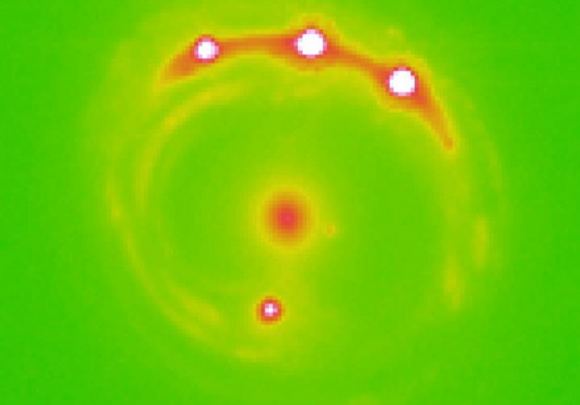
As Xinyu Dai explained in a recent University of Oklahoma press release:
“We are very excited about this discovery. This is the first time anyone has discovered planets outside our galaxy. These small planets are the best candidate for the signature we observed in this study using the microlensing technique. We analyzed the high frequency of the signature by modeling the data to determine the mass.”
While 53 planets have been discovered within the Milky Way galaxy using the Microlensing technique, this is the first time that planets have been observed in other galaxies. Much like the first confirmed discovery of an extra-solar planet, scientists were not even certain planets existed in other galaxies prior to this study. This discovery has therefore brought the study of planets beyond our Solar System to a whole new level!
And as Eduardo Guerras indicated, the discovery was possible thanks to improvements made in both modelling and instrumentation in recent years:
“This is an example of how powerful the techniques of analysis of extragalactic microlensing can be. This galaxy is located 3.8 billion light years away, and there is not the slightest chance of observing these planets directly, not even with the best telescope one can imagine in a science fiction scenario. However, we are able to study them, unveil their presence and even have an idea of their masses. This is very cool science.”
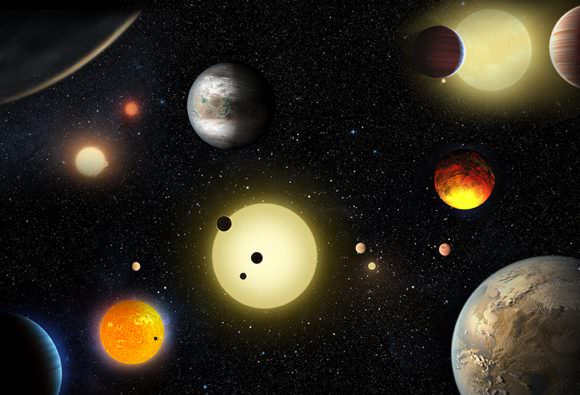
In the coming years, more sophisticated observatories will be available, which will allow for even more in the way of discoveries. These include space-based instruments like the James Webb Space Telescope (which is scheduled to launch in Spring of 2019) and ground-based observatories like the ESO’s OverWhelmingly Large (OWL) Telescope, the Very Large Telescope (VLT), the Extremely Large Telescope (ELT), and the Colossus Telescope.
At this juncture, the odds are good that some of these discoveries will be in neighboring galaxies. Perhaps then we can begin to determine just how common planets are in our Universe. At present, it is estimated that could be as many as 100 billion planets in the Milky Way Galaxy alone! But with an estimated 1 to 2 trillion galaxies in the Universe… well, you do the math!
Further Reading: University of Oklahoma, The Astrophysical Journal Letters
The New Earth-Sized Planet Hunting Telescope ExTrA is Now Online
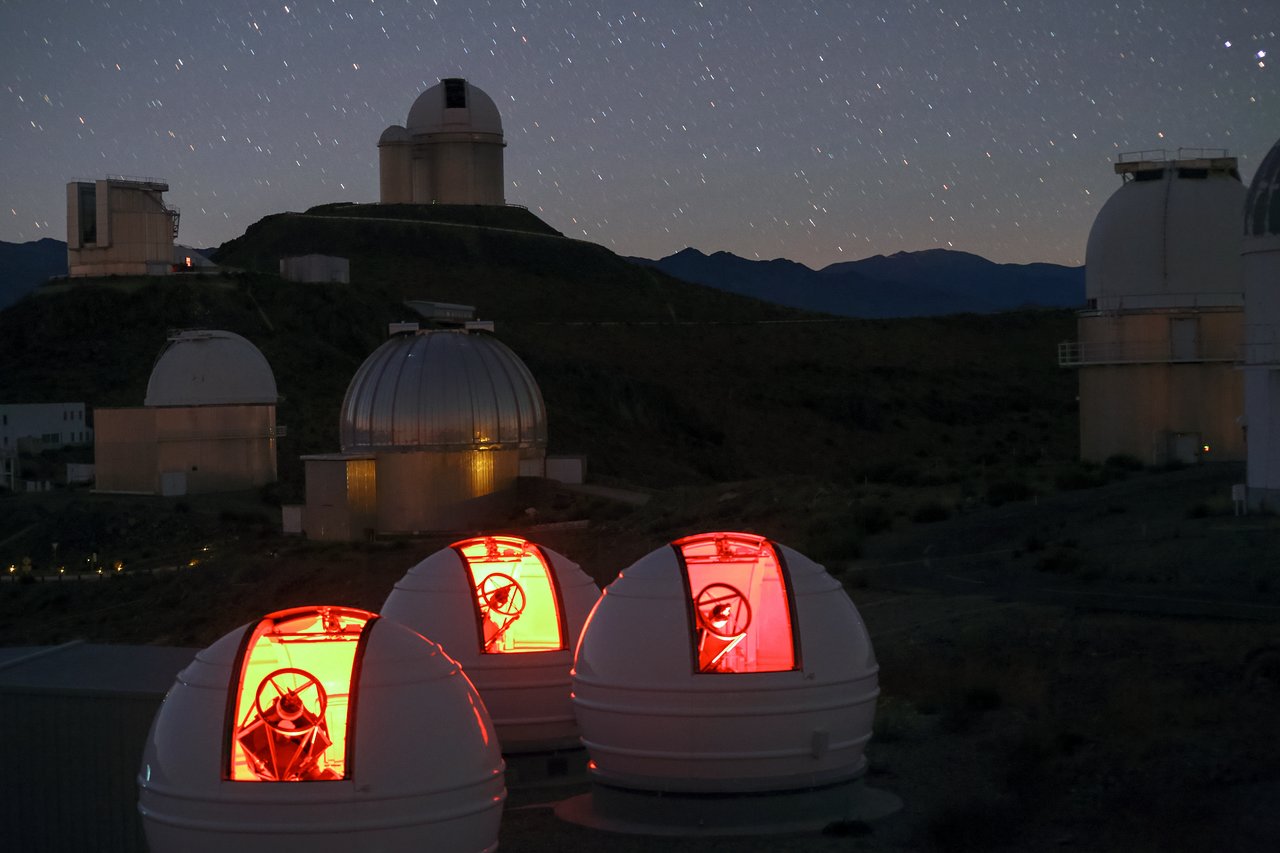
Ever since the Kepler space telescope began discovering thousands of exoplanets in our galaxy, astronomers have been eagerly awaiting the day when next-generation missions are deployed. These include the much-anticipated James Webb Space Telescope, which is scheduled to take to space in 2019, but also the many ground-based observatories that are currently being constructed.
One of these is the Exoplanets in Transits and their Atmospheres (ExTrA) project, which is the latest addition to the ESO’s La Silla Observatory in Chile. Using the Transit Method, this facility will rely on three 60-centimeter (23.6 in) telescopes to search for Earth-sized exoplanets around M-type (red dwarf) stars in the Milky Way Galaxy. This week, the facility began by collecting its first light.
The Transit Method (aka. Transit Photometry) consists of monitoring stars for periodic dips in brightness. These dips are caused by planets passing in front of the star (aka. transiting) relative to the observer. In the past, detecting planets around M-type stars using this method has been challenging since red dwarfs are the smallest and dimmest class of star in the known Universe and emit the majority of their light in the near-infrared band.
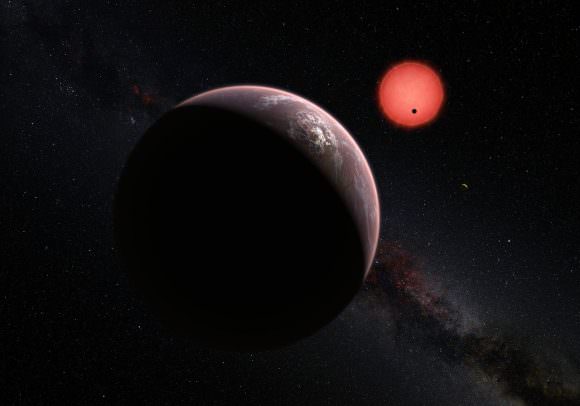
However, these stars have also proven to be treasure trove when it comes to rocky, Earth-like exoplanets. In recent years, rocky planets have been discovered around star’s like Proxima Centauri and Ross 128, while TRAPPIST-1 had a system of seven rocky planets. In addition, there have been studies that have indicated that potentially-habitable, rocky planets could be very common around red dwarf stars.
Unlike other facilities, the ExTrA project is well-suited to conduct surveys for planets around red dwrfs because of its location on the outskirts of the Atacama Desert in Chile. As Xavier Bonfils, the project’s lead researcher, explained:
“La Silla was selected as the home of the telescopes because of the site’s excellent atmospheric conditions. The kind of light we are observing – near-infrared – is very easily absorbed by Earth’s atmosphere, so we required the driest and darkest conditions possible. La Silla is a perfect match to our specifications.”
In addition, the ExTrA facility will rely on a novel approach that involves combining optical photometry with spectroscopic information. This consists of its three telescopes collecting light from a target star and four companion stars for comparison. This light is then fed through optical fibers into a multi-object spectrograph in order to analyze it in many different wavelengths.
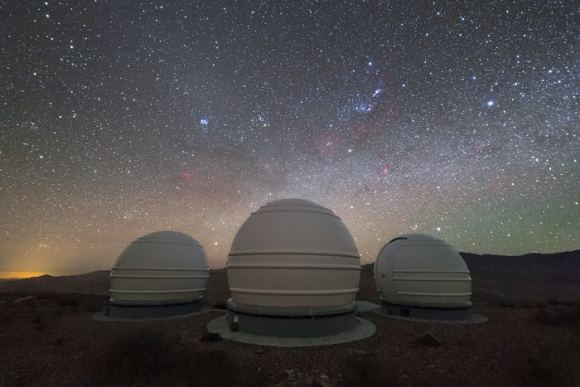
This approach increases the level of achievable precision and helps mitigate the disruptive effect of Earth’s atmosphere, as well as the potential for error introduced by instruments and detectors. Beyond the goal of simply finding planets transiting in front of their red dwarf stars, the ExTrA telescopes will also study the planets it finds in order to determine their compositions and their atmospheres.
In short, it will help determine whether or not these planets could truly be habitable. As Jose-Manuel Almenara, a member of the ExTrA team, explained:
“With ExTrA, we can also address some fundamental questions about planets in our galaxy. We hope to explore how common these planets are, the behaviour of multi-planet systems, and the sorts of environments that lead to their formation,”
The potential to search for extra-solar planets around red dwarf stars is an immense opportunity for astronomers. Not only are they the most common star in the Universe, accounting for 70% of stars in our galaxy alone, they are also very long-lived. Whereas stars like our Sun have a lifespan of about 10 billion years, red dwarfs are capable of remaining in their main sequence phase for up to 10 trillion years.

For these reasons, there are those who think that M-type stars are our best bet for finding habitable planets in the long run. At the same time, there are unresolved questions about whether or not planets that orbit red dwarf stars can stay habitable for long, owing to their variability and tendency to flare up. But with ExTrA and other next-generation instruments entering into service, astronomers may be able to address these burning questions.
As Bonfils excitedly put it:
“With the next generation of telescopes, such as ESO’s Extremely Large Telescope, we may be able to study the atmospheres of exoplanets found by ExTra to try to assess the viability of these worlds to support life as we know it. The study of exoplanets is bringing what was once science fiction into the world of science fact.”
ExTrA is a French project funded by the European Research Council and the French Agence National de la Recherche and its telescopes will be operated remotely from Grenoble, France. Also, be sure to enjoy this video of the ExTrA going online, courtesy of the ESOcast:
Further Reading: ESO
Upcoming Telescopes Should be Able to Detect Mountains and Other Landscapes on Extrasolar Planets

The study of exoplanets has advanced by leaps and bounds in the past few decades. Between ground-based observatories and spacecraft like the Kepler mission, a total of 3,726 exoplanets have been confirmed in 2,792 systems, with 622 systems having more than one planet (as of Jan. 1st, 2018). And in the coming years, scientists expect that many more discoveries will be possible thanks to the deployment of next-generation missions.
These include NASA’s James Webb Space Telescope (JWST) and several next-generation ground based observatories. With their advanced instruments, these and other observatories are not only expected to find many more exoplanets, but to reveal new and fascinating things about them. For instance, a recent study from Columbia University indicated that it will be possible, using the Transit Method, to study surface elevations on exoplanets.
The study, which recently appeared online under the title “Finding Mountains with Molehills: The Detectability of Exotopography“, was conducted by Moiya McTier and David Kipping – and graduate student and an Assistant Professor of Astronomy at Columbia University, respectively. Based on models they created using bodies in our Solar System, the team considered whether transit surveys might be able to reveal topographical data on exoplanets.
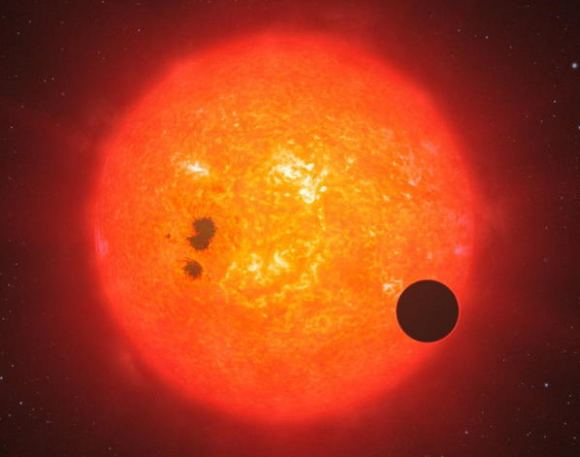
To recap, the Transit Method (aka. Transit Photometry) is currently the most popular and reliable means for detecting exoplanets. It consists of astronomers measuring the light curve of distant stars over time and looking for periodic dips in brightness. These dips are the result of exoplanets passing in front of the star (i.e. transiting) relative to the observer.
By measuring the rate at which the star’s light dips, and the period with which the dimming occurs, astronomer are not only able to determine the presence of exoplanets, but also place accurate constraints on their size and orbital periods. According to McTier and Kipping, this same method could also reveal the presence of geographical features – for instance, mountain ranges, volcanoes, trenches, and craters.
As they indicate in their study, in lieu of direct imaging, indirect methods are the only means astronomers have for revealing data on an exoplanet’s surface. Unfortunately, there is no conceivable way that the radial velocity, microlensing, astrometry, and timing methods could reveal exotopography. This leaves the transit method, which has some potential in this respect. As they state:
“The transit method directly measures the sky-projected area of a planet’s silhouette relative to that of a star, under the assumption that the planet is not luminous itself… This fact implies that there is indeed some potential for transits to reveal surface features, since the planet’s silhouette is certainly distorted from a circular profile due to the presence of topography.”

In other words, as a planet transits in front of its host star, the light passing around the planet itself could be measured for small variations. These could indicate the presence of mountain ranges and other large-scale features like massive chasms. To test this theory, they considered planets in the Solar System as templates for how the scattering of light during a transit could reveal large-scale features.
As an example, they consider what an Earth analog planet would reveal if the Himalayan mountain range ran from north to south and was wide enough to span 1° in longitude:
“Now assume that the planet completes half of one rotation as it transits its parent star from our point of view, which is all that is necessary to see all of the planet’s features appear on its silhouette without repeating. As our hypothetical planet rotates and the Himalayan block moves into and out of view, the change in silhouette will result in different transit depths…”
Ultimately, they consider that Mars would be the ideal test case due to its combination of small size, low surface gravity, and active internal volcanism, which has caused it become what they describe as the “bumpiest body in the Solar System”. When paired with a white dwarf star, this presents the optimal case for using light curves to determine exotopography.
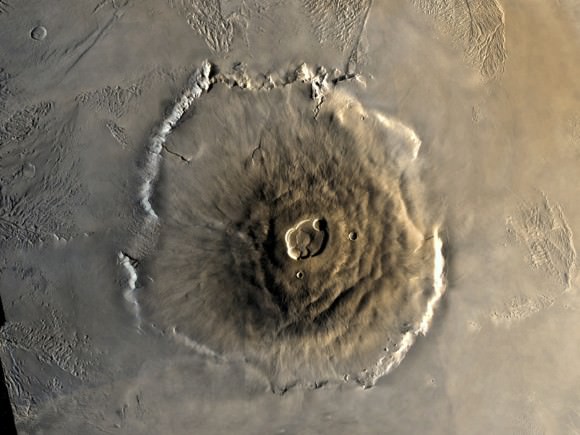
At a distance of about 0.01 AU (which would be within a white dwarf’s habitable zone), they calculate that a Mars-sized planet would have an orbital period of 11.3 hours. This would allow for many transits to be observed in a relatively short viewing period, thus ensuring a greater degree of accuracy. At the same time, the team admits that their proposed methods suffers from drawbacks.
For instance, due to the presence of astrophysical and instrumental noise, they determined that their method would be unproductive when it comes to studying exoplanets around Sun-like stars and M-type (red dwarf) stars. But for Mars-like planets orbiting low mass, white dwarf stars, the method could produce some highly valuable scientific returns.
While this might sound rather limited, it would present some rather fascinating opportunities to learn more about planets beyond our Solar System. As they explain:
“Finding the first evidence of mountains on planets outside our solar system would be exciting in its own right, but we can also infer planet characteristics from the presence and distribution of surface features. For example, a detection of bumpiness could lead to constraints on a planet’s internal processes.”
In short, planets with a high degree of bumpiness would indicate tectonic activity or the buildup of lava caused by internal heating sources. Those with the highest bumpiness (i.e. like Mars) would indicate that they too experience a combination internal processes, low surface gravity, volcanism, and a lack of tectonic plate movement. Meanwhile, low-bumpiness planets are less likely to have any of these internal processes and their surfaces are more likely to be shaped by external factors – like asteroid bombardment.
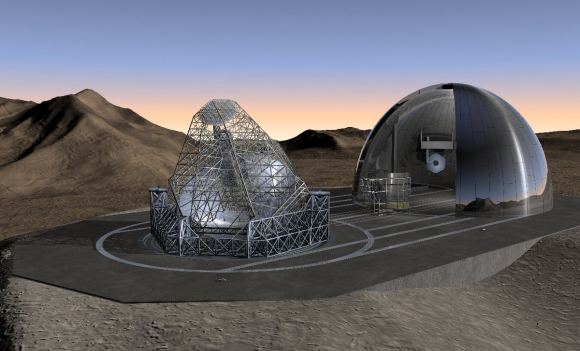
Based on their estimates, they conclude that the various super telescopes that are scheduled to be commissioned in the coming years would be up to task. These include the ESO’s OverWhelmingly Large (OWL) Telescope, a 100-meter proposed optical and near-infrared telescope that would build on the success of the Very Large Telescope (VLT) and the upcoming Extremely Large Telescope (ELT).
Another example is the Colossus Telescope, a 74-meter optical and infrared telescope that is currently being commissioned by an international consortium. Once operational, it will be the largest telescope optimized for detecting extrasolar life and extraterrestrial civilizations.
In the past, the success of exoplanet hunters has come down to a combination of factors. In addition to greater levels of cooperation between institutions, amateur astronomers and citizen scientists, there has also been the way in which improved technology has coincided with new theoretical models. As more data become available, scientists are able to produce more educated estimates on what we might be able to learn once new instruments come online.
When the next-generation telescopes take to space or are finished construction here on Earth, we can anticipate that thousands more exoplanets will be found. At the same time, we can anticipate that important details will be also discovered about these planets that were not possible before. Do they have atmospheres? Do they have oceans? Do they have mountain ranges and chasms? We hope to find out!
Further Reading: arXiv
What is the Radial Velocity Method?

Welcome back to our series on Exoplanet-Hunting methods! Today, we look at another widely-used and popular method of exoplanet detection, known as the Radial Velocity (aka. Doppler Spectroscopy) Method.
The hunt for extra-solar planets sure has heated up in the past decade or so! Thanks to improvements made in instrumentation and methodology, the number of exoplanets discovered (as of December 1st, 2017) has reached 3,710 planets in 2,780 star systems, with 621 system boasting multiple planets. Unfortunately, due to the limits astronomers are forced to contend with, the vast majority have been discovered using indirect methods.
When it comes to these indirect methods, one of the most popular and effective is the Radial Velocity Method – also known as Doppler Spectroscopy. This method relies on observing the spectra stars for signs of “wobble”, where the star is found to be moving towards and away from Earth. This movement is caused by the presence of planets, which exert a gravitational influence on their respective sun.

